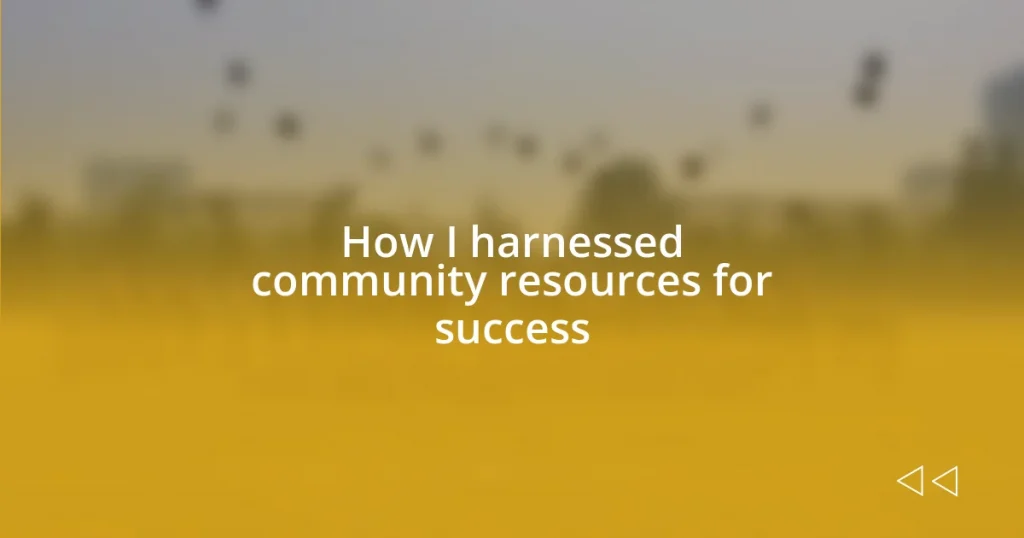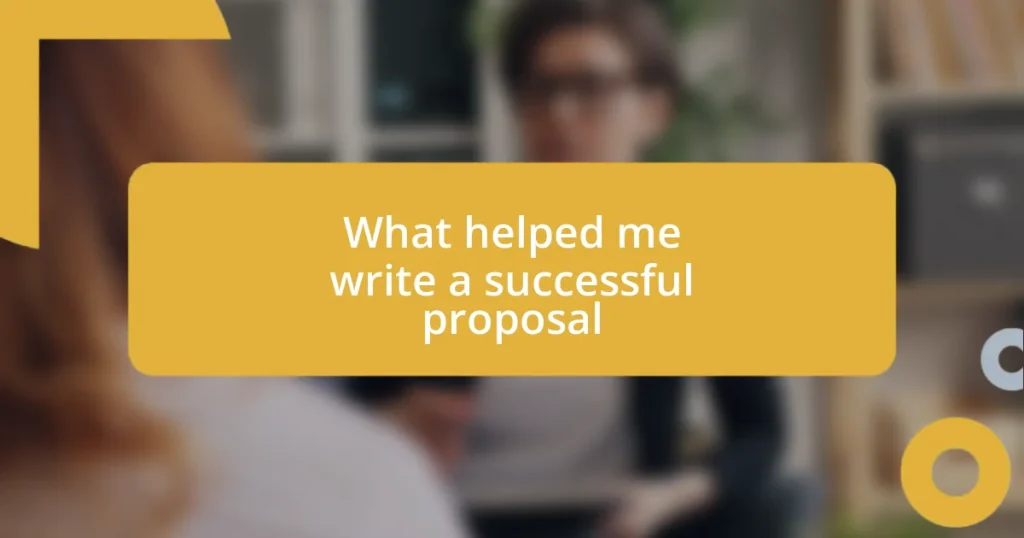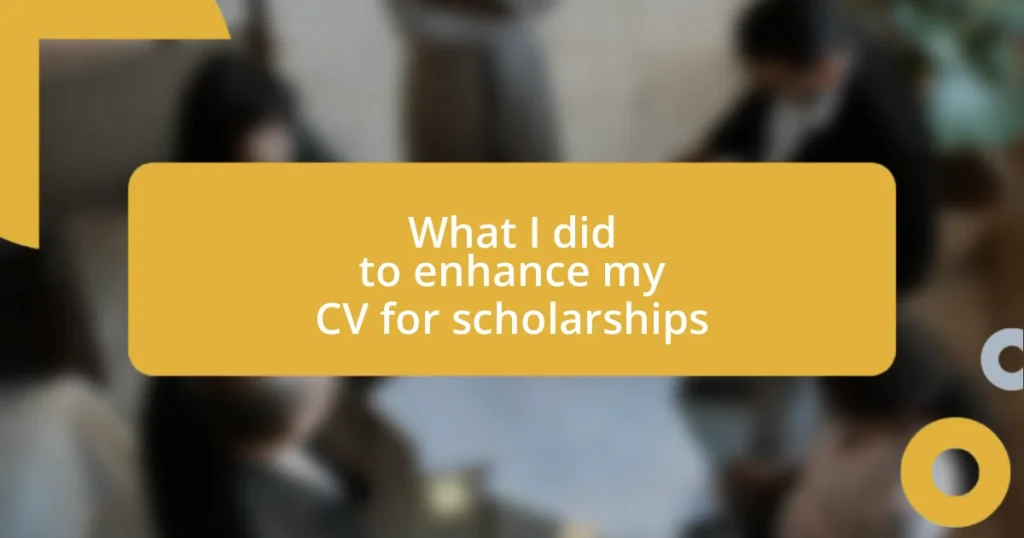Key takeaways:
- Community resources are often overlooked but can offer invaluable support through relationships, mentorship, and networking opportunities.
- Identifying local assets, such as community centers, libraries, and local businesses, can significantly enhance project success through collaboration and resource-sharing.
- Sustaining community engagement involves continuous communication, recognition of contributions, and fostering an environment of trust and belonging.
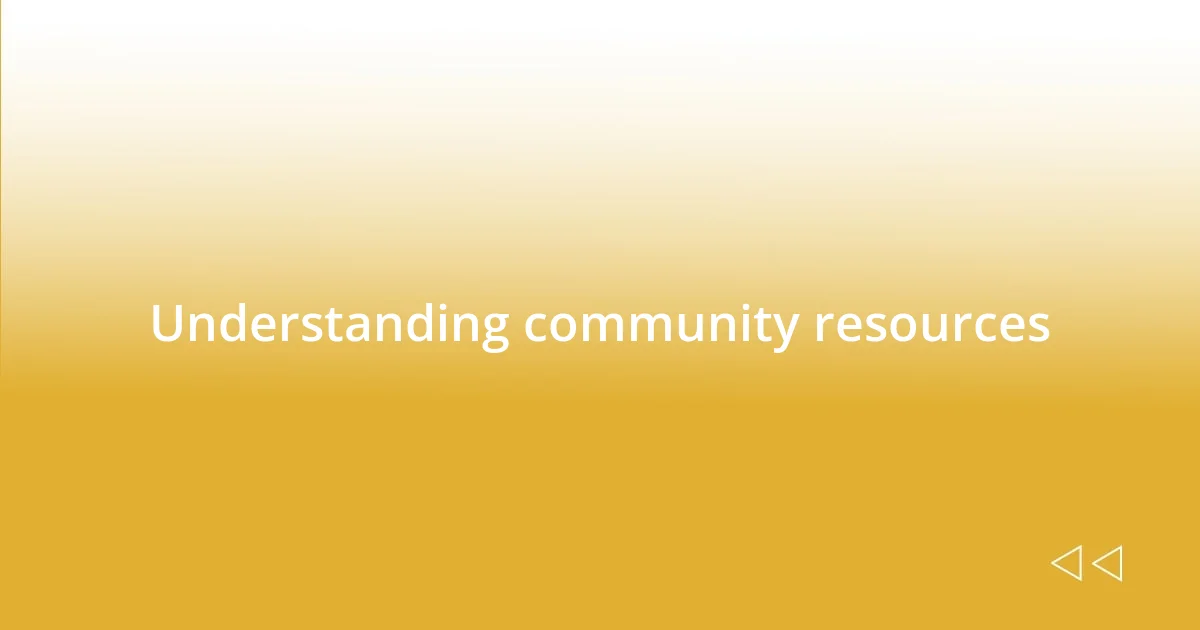
Understanding community resources
Community resources are often the hidden gems that can make a significant difference in our lives. I remember when I first sought support for my project; I was amazed at how many local organizations were eager to help. It made me wonder, how many of us overlook these resources simply because we don’t know they exist?
At times, tapping into community resources can feel overwhelming. It might seem like a Herculean task to navigate through local services, from libraries offering free workshops to nonprofits with expert advice. However, I learned that starting small – like attending a local meet-up – can lead to valuable connections and unexpected support. Have you ever found yourself in a similar situation, unsure of where to begin?
Through my experiences, I’ve come to appreciate how community resources are not just about financial aid or services; they are about building relationships and fostering a sense of belonging. When I connected with a local mentorship program, I realized that the emotional encouragement and networking opportunities were just as crucial to my success as any material support. Isn’t it fascinating how a simple conversation can spark a journey toward achieving our goals?
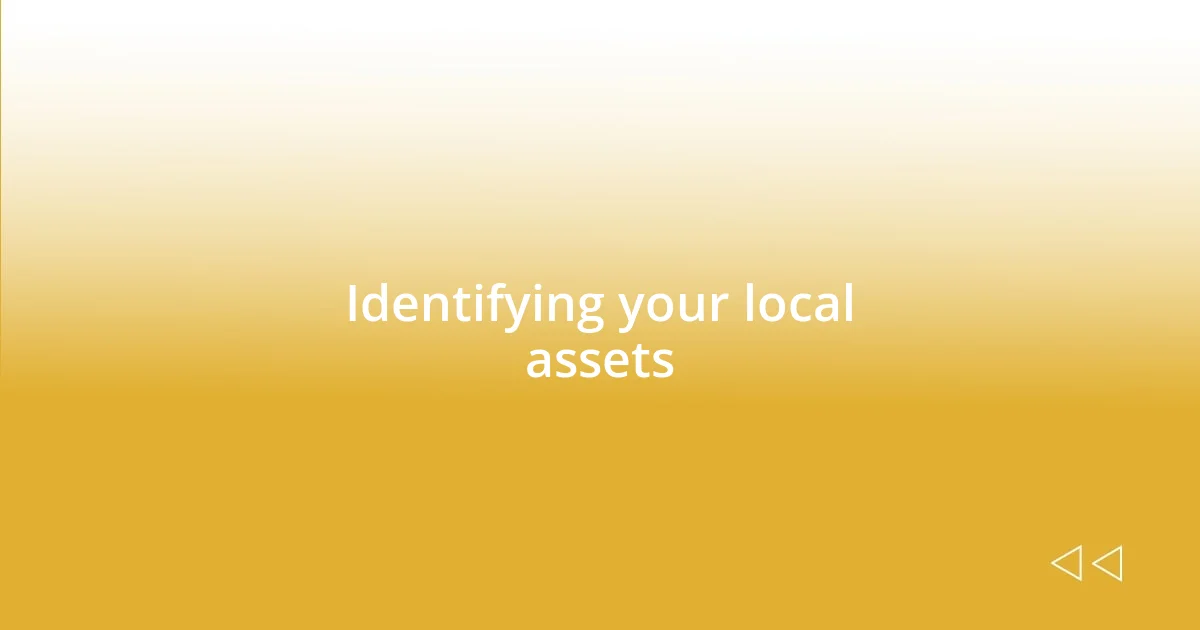
Identifying your local assets
To effectively identify local assets, I often suggest starting with what you already know. Think about the businesses, schools, and organizations in your area. When I needed resources for my community project, I made a list of local groups I had seen thrive in the neighborhood, from the community center that hosts regular events to the local coffee shop that showcases local artists. It’s incredible how these seemingly small entities are packed with potential support.
Here are some local assets to consider:
- Community Centers: They often provide workshops, meet-ups, and events that can connect you with others.
- Libraries: Beyond books, they offer resources like classes and networking events.
- Local Businesses: Many are keen to support community initiatives through partnerships.
- Schools and Universities: They may have programs or students looking for real-world experience.
- Faith-Based Organizations: These can be great sources of support or volunteers for community-driven efforts.
- Social Media Groups: Utilizing platforms like Facebook can help you discover local interests and initiatives.
By focusing on these areas, you can uncover a treasure trove of resources just waiting to be leveraged for your success. As I explored these options, I found unexpected allies who changed the course of my project. Each conversation opened doors I didn’t know existed, and it felt rewarding to connect on a deeper level with my community.
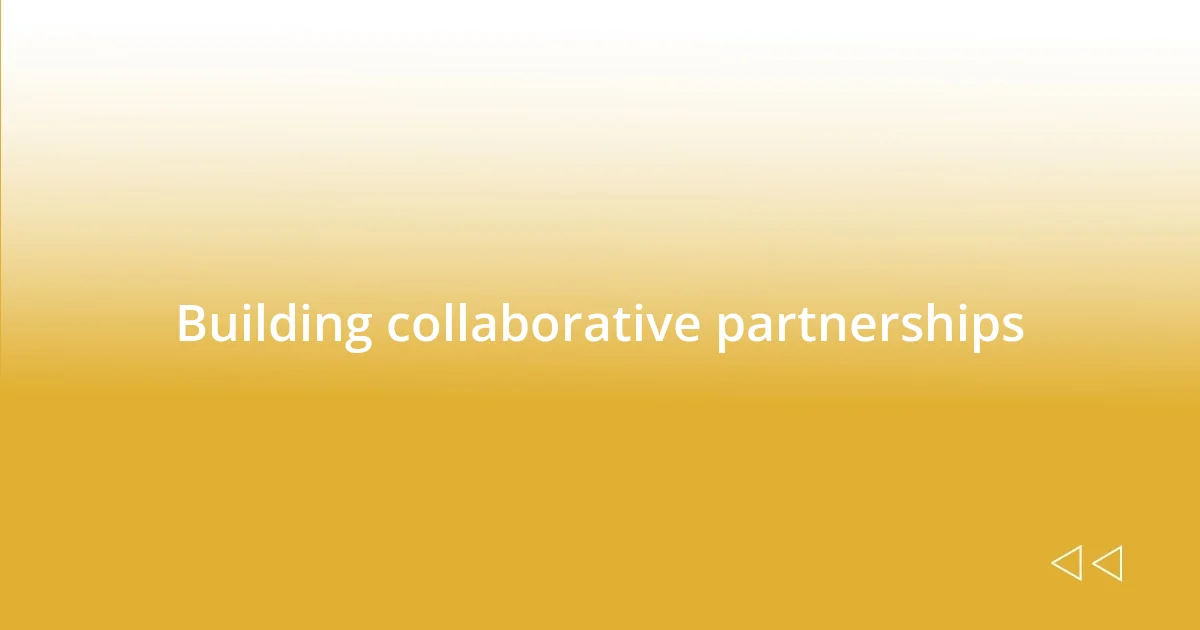
Building collaborative partnerships
Building collaborative partnerships was a game changer for my projects. I vividly recall reaching out to a local nonprofit that shared my vision. They were thrilled to collaborate, and our joint efforts not only amplified our impact but also fostered friendships that I deeply value. I often think about how these mutually beneficial relationships can transform our goals into reality. Have you ever formed a partnership that exceeded your expectations?
Collaboration isn’t just about sharing resources; it’s about creating a sense of unity. During one particularly challenging phase of my project, I joined forces with a local artist who offered their creative skills in exchange for exposure. This arrangement not only enriched my project aesthetically but also opened doors to new audiences. It’s fascinating how pooling talents can lead to such innovative outcomes, isn’t it?
I’ve seen firsthand that establishing transparent communication plays a vital role in maintaining these partnerships. Early on, I made an effort to regularly check in with my collaborators to ensure everyone felt heard and valued. This practice not only built trust but also encouraged the sharing of ideas that enhanced our collective efforts. It’s amazing how setting aside time for open dialogue can strengthen bonds and lead to success beyond what we initially envisioned.
| Key Aspects | Examples |
|---|---|
| Shared Goals | Collaborating for a common objective, like hosting community events. |
| Mutual Support | Exchanging resources, skills, or knowledge with local partners. |
| Building Trust | Regular communication to ensure everyone’s voice is heard. |
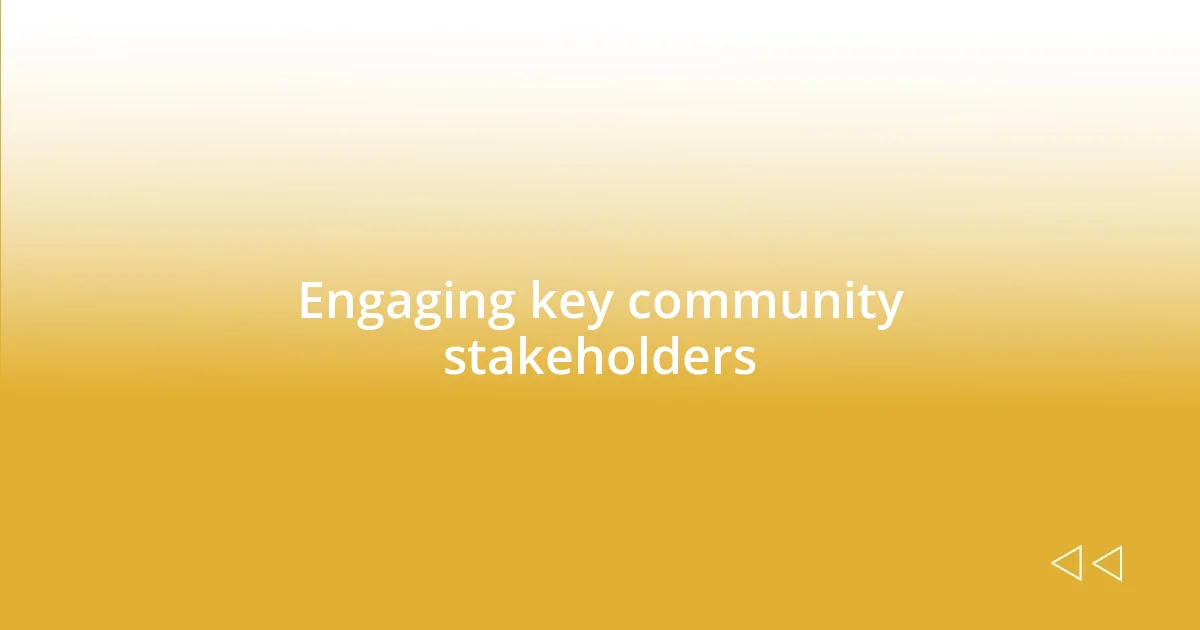
Engaging key community stakeholders
Engaging key community stakeholders can truly elevate any project to new heights. When I set out to launch a community initiative, I vividly remember the moment I approached our local school principal. I was nervous, unsure of how she would perceive my ideas. To my surprise, she not only welcomed the conversation but actively sought ways we could integrate students into the project. Isn’t it incredible how reaching out to just one person can lead to a cascade of support and enthusiasm?
In another instance, while attending a neighborhood meeting, I met a retired business owner who seemed unassuming at first. As we chatted, I learned about his vast network and experience. Inviting him to partner with me sparked a lively exchange of ideas and resources that neither of us had expected. This encounter taught me an important lesson: sometimes, the most valuable connections come from the least likely places, don’t you think?
I also found that involving stakeholders early on in the planning process not only garnered their support but also inspired a sense of ownership. I invited community members to contribute their thoughts and feedback, which fostered an environment where everyone felt invested. This collective effort made my project stronger and more relatable. Have you ever noticed how including others in the journey can bring people together in ways you wouldn’t have imagined? It’s truly a rewarding process.
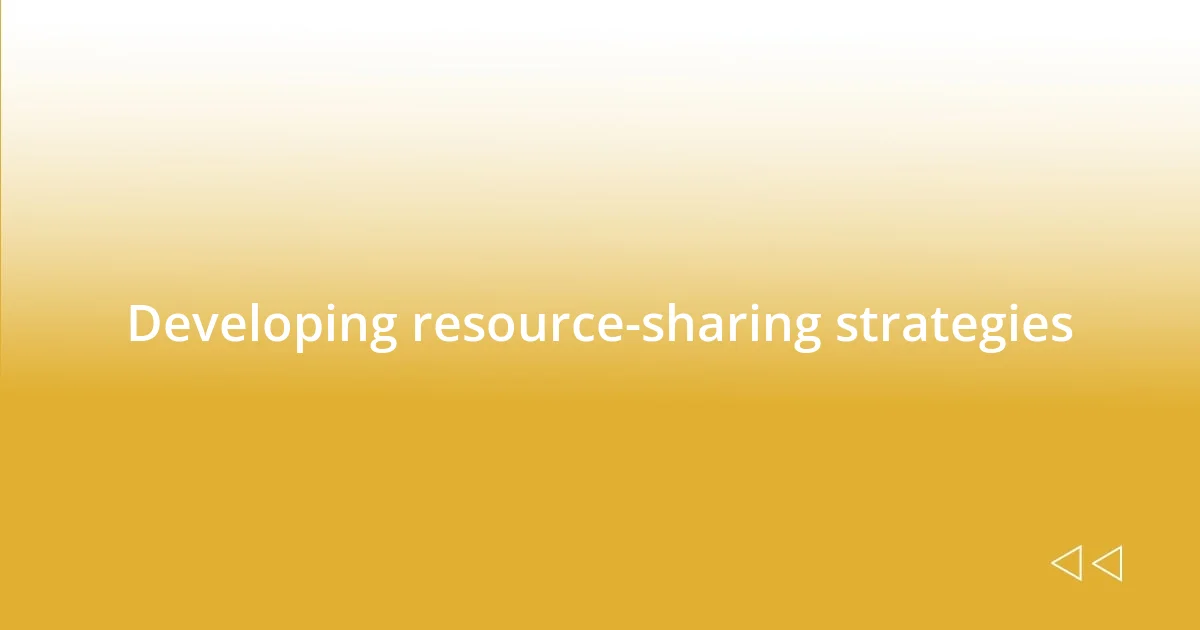
Developing resource-sharing strategies
When I started to think about resource-sharing strategies, I quickly realized that the key was identifying common needs within my community. For instance, when working on a neighborhood cleanup project, I discovered that several local businesses were eager to contribute supplies like trash bags and refreshments. This simple realization turned into a win-win situation: the businesses gained visibility while our volunteers felt appreciated and supported. It’s amazing how collaboration can emerge when you simply ask, isn’t it?
One approach that worked wonders for me was holding informal brainstorming sessions with stakeholders. We sat in a cozy café, exchanging ideas over coffee, and what surprised me was the variety of resources people were willing to share. From skills to equipment, we tapping into strengths we hadn’t even thought of before. Establishing a casual environment made it easier for everyone to open up. Have you ever noticed how creative ideas flow better in a relaxed setting?
I found that creating a shared online platform to catalog resources became invaluable. This digital hub allowed everyone involved to list what they had available and what they needed, making it much easier to connect. I vividly remember one instance where a community garden project benefited from a neighbor who offered her gardening tools, while another participant provided seeds. This resource exchange didn’t just help us get the job done; it fostered a sense of community pride and camaraderie. Isn’t it remarkable how technology can bridge gaps and enhance our collective efforts?
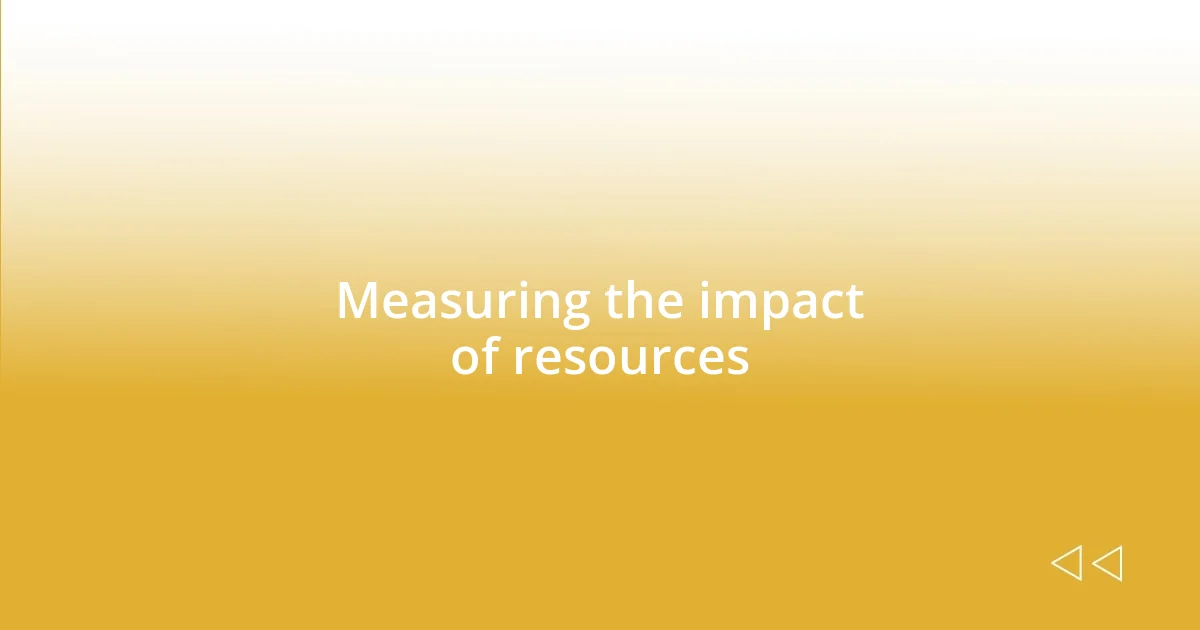
Measuring the impact of resources
Measuring the impact of community resources requires careful consideration of both qualitative and quantitative metrics. One of the most fascinating experiences I had involved tracking participation rates in our local mentorship program. I remember how excited I felt when we noticed a 30% increase in enrollments after introducing our resource-sharing strategy. It made me realize that tangible numbers tell only part of the story; the real impact shone through in the heartfelt testimonials from participants who felt more supported than ever.
In another project aimed at enhancing local literacy, I utilized feedback forms after each session. I was pleasantly surprised to discover not only high satisfaction ratings but also personal anecdotes like, “I finally found the courage to read aloud because of this group!” Such insights provided a deeper understanding of how our community initiatives truly resonated. Have you ever taken a moment to reflect on how feedback can sometimes reveal more than mere statistics?
Lastly, I learned the power of storytelling during my evaluation process. By sharing success stories at community meetings, I could visibly witness engagement soar. People connected emotionally with the narratives. For instance, when I shared how a young woman overcame personal challenges to lead a reading group, I noticed more individuals stepping forward to volunteer. It made me think—what if we all took the time to highlight our shared victories? Wouldn’t that inspire even greater community involvement?
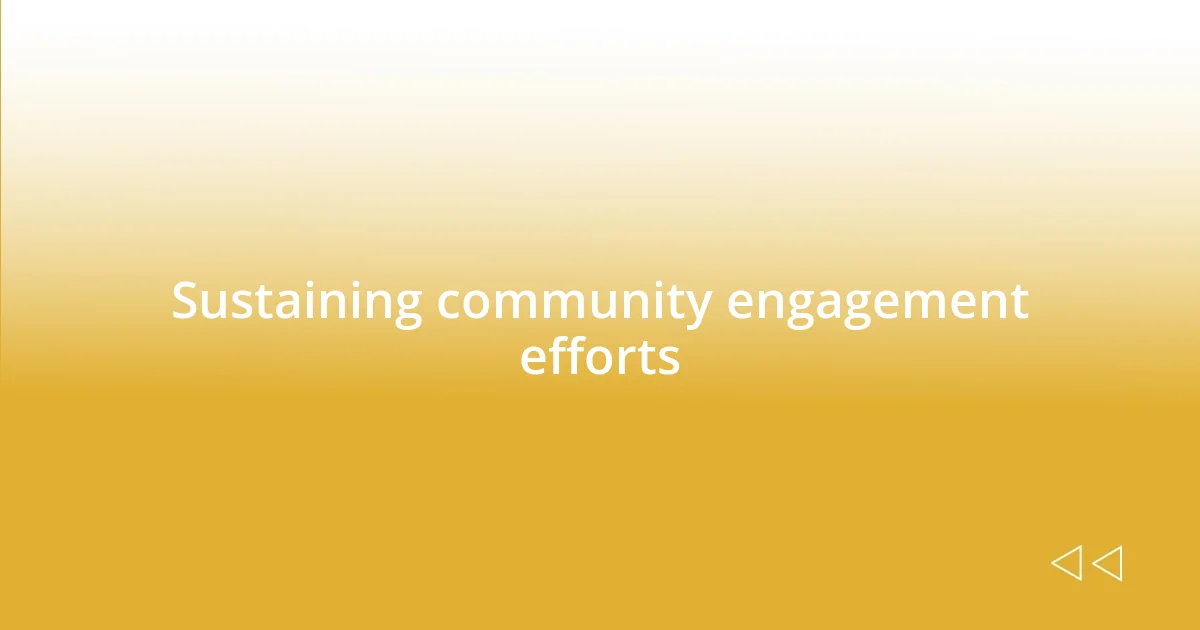
Sustaining community engagement efforts
I believe sustaining community engagement efforts is all about relationship-building. When I worked on youth programs, I noticed that sending out regular newsletters made a huge difference. It wasn’t just about informing; it was about creating a dialogue. In one memorable instance, a parent reached out to me after reading a success story in one of our newsletters. She expressed her appreciation, and that simple connection turned into her volunteering for future events. Have you ever witnessed how a small gesture of communication can spark a sense of belonging?
Another effective method I discovered was hosting quarterly community forums. These gatherings became an open space where everyone could share updates and concerns. I recall an elderly resident sharing her thoughts on community safety, and it led to a collaborative safety watch program. This event wasn’t just about exchanging ideas; it cultivated trust among participants. When people feel heard, they’re more likely to stay engaged. It’s fascinating how a conversation can create lasting commitments, don’t you think?
I also learned that recognizing contributions goes a long way in keeping the momentum going. For example, during a city-wide cleanup, I made it a point to spotlight volunteers through social media shout-outs. One of the volunteers, who had been shy and reluctant to engage, told me how encouraging it felt to be acknowledged publicly. That moment reminded me that gratitude nurtures loyalty and inspires further participation. What happens when we celebrate small victories together? We create a community that thrives on support and shared success!










